LHR>JNB>PLZ
People sometimes seem to have a misconception that South Africa is dangerous. Like with areas of London, or indeed any major city, there are areas in Johannesburg that are rougher than others and aren’t advisable to venture into, but I went on a tour of Joburg as a young, white female solo traveller and didn’t feel uneasy. South Africa is an amazing place so don’t let these misconceptions put you off travelling there!
My first trip was to look around Pretoria University with my parents because I was applying there for vet school. The campus at Onderstepoort is unbelievable; it’s a dedicated veterinary campus with huge grounds and fantastic facilities. We made a trip of it and went to Kruger National Park on safari afterwards. It is just amazing to be driving along and then bump into giraffes or rhino or elephants! By this point, I was hooked on the idea of going to SA for vet school and having the opportunity to work with animals like this.
The same year, I went with my mum to spend two weeks working at African Dawn Wildlife Sanctuary in Thornhill. Most of the work was preparing food or cleaning out enclosures, they have a huge variety of animals from cheetah to marmosets.

Our accommodation 
Kitchen Windows meal 
Billabong Pro 
On the weekends we had free time to go and explore the surrounding area. We had the chance to go and watch the Billabong Pro Surfing Championships that were going on in nearby Jeffrey’s Bay. We had one of the best meals I’ve ever had at Kitchen Windows, overlooking the beach with the most amazing drool-worthy seafood. The World’s Highest Bungee at Bloukrans Bridge wasn’t that far away from the sanctuary and I (at the time!) thought this would be a great thing to do….. Whilst I’m glad I did it I don’t think I’ll be rushing to do a bungee jump again anytime soon! You can see a video of my jump here.
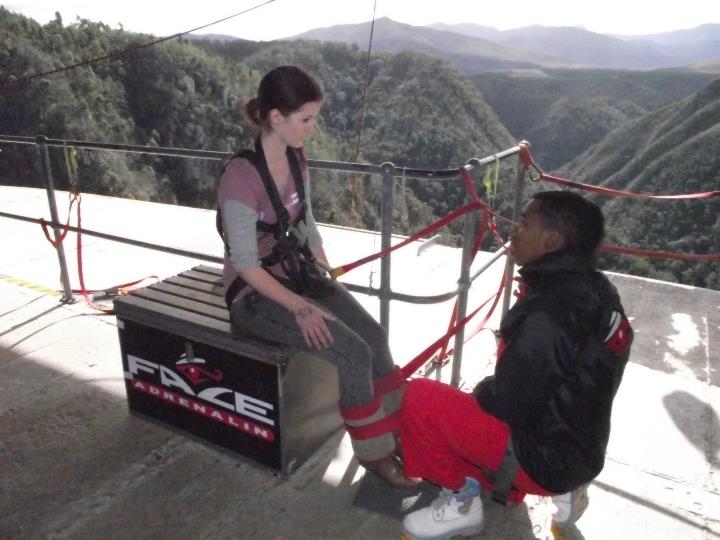
South Africa 2015
My first solo adventure was to Shamwari Game Reserve on an organised veterinary extra-mural studies trip. It is a two-week veterinary course designed for students who are already in vet school. I flew into Johannesburg and then got an internal flight to Port Elizabeth. From there, it’s about an hour or so to the game reserve. The accommodation is a small complex on the far northern side of the reserve. The veterinary unit operates from the southern point of the reserve, meaning that every time you travel to or from the accommodation you are on safari! On the first evening, we sat around a bonfire introducing ourselves and Charlotte and Konrad (our guides) told us about the plan for the next day. We were going to be watching an operation that was taking place on a poached rhino. I went to bed that night excited about the day ahead but not really knowing what awaited us.
The next day we watched Hope the white rhino being operated on and essentially it was this event that recentred my focus for working with wild animals. You may have heard of her as she was the poster child for the anti-poaching campaign in South Africa for a while. When we were told that on our first full day we would be going to watch an operation on a rhino that had been poached I had no idea what to expect. No idea. In actuality, the reality was far worse. I had never seen wounds like it. Just horrific.
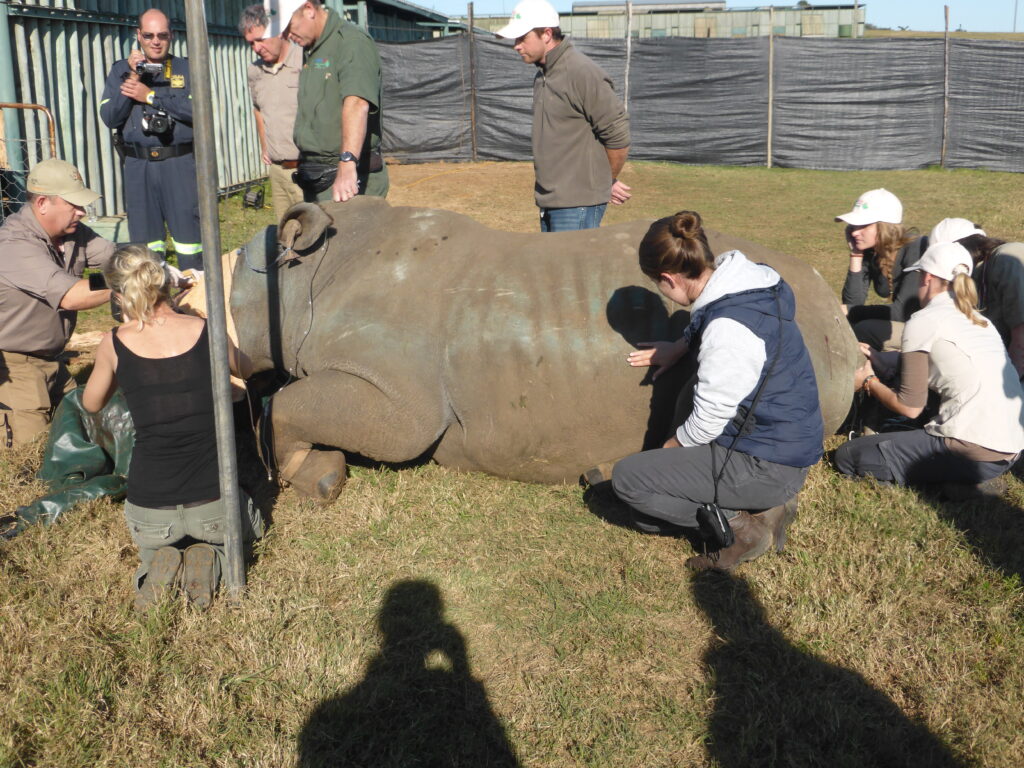
It was such a harrowing and yet awe-inspiring moment. It really solidified for me that I needed to help with work like this in the future to truly feel fulfilled. Hope had been found in the bush about 3 days after the poaching had taken place, alone and bleeding. Poachers are sometimes not detected straight away because instead of guns, darts are sometimes used to create less noise. Poaching is often done on the full moon because it is so bright in the bush and that it makes it far easier to see the animals. The full moon is called the ‘poacher’s moon’ to those that fear the threat on their land. The operation was to cover the enormous wound that had been left after the poachers had taken her horn. Watching Dr Johan Marais of Saving the Survivors and Dr William Fowlds, two experts in the fieldwork was utterly remarkable and something I will never forget.
Over the two weeks, we did new things every day. This ranged from helping with animals that needed to be translocated to another reserve or helping out at the wildlife rehabilitation centre. The first time I ever pulled blood was on a bontebok. They were being sold to another game reserve for breeding purposes and so needed to be tagged and blood was taken. Quite the precedent to be set when my first blood draw was on a species I didn’t know existed until two days previously!
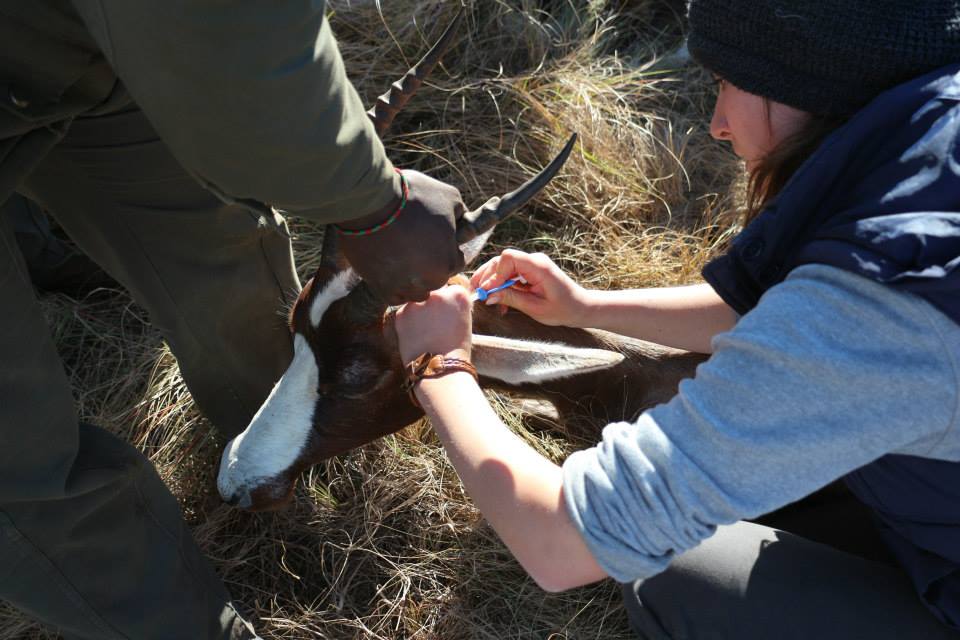
I’m not sure how it happened now, I think because I’d expressed a particular interest in big cats when we first met with Johan the vet, I was volunteered to put a contraceptive implant into a white lioness at the Born Free Sanctuary which is located within Shamwari Game Reserve. This sanctuary cares for mistreated lions and leopards from circuses and similar situations and so they cannot be released onto the reserve.
The couple that we were dealing with was a male and female white lion pair who had both been in the canned hunting industry with a price on their head. Born Free had obtained these lions and brought them to the sanctuary as their ‘retirement home’. They obviously do not want the lions or leopards breeding at the sanctuary so there I was in a cage with a white lioness putting in a contraceptive implant so she could be with her male beau without the threat of the patter of tiny paws.
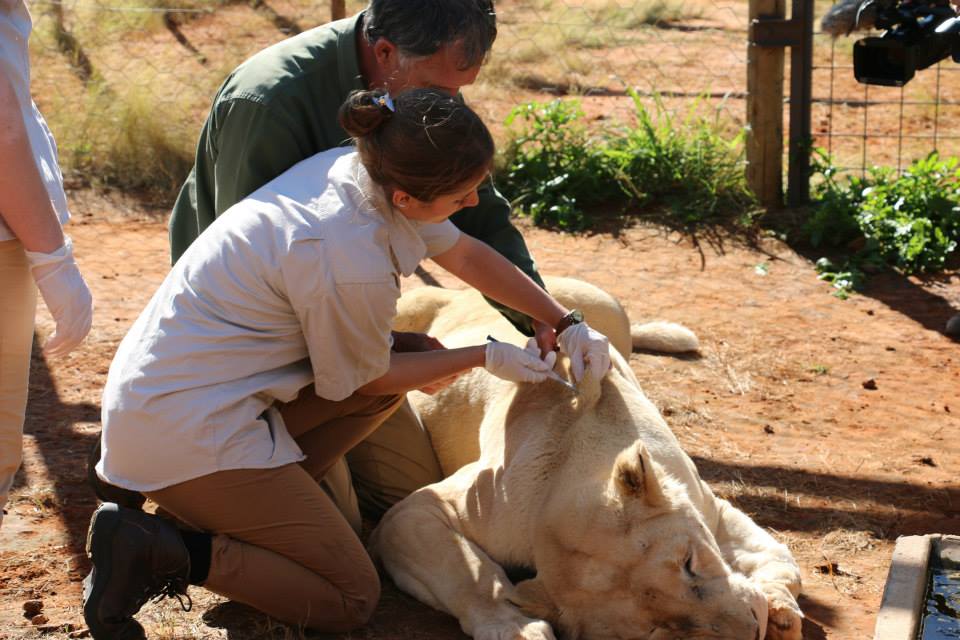
Canned hunting is the hunting of wild animals in large enclosures. The enclosures are big but it means there is no escape for the animal. People pay thousands upon thousands of dollars just to shoot one of the Big 5 or other prestigious African wildlife for their trophy collection or just for the thrill of it. Certainly, with lions, the cub petting industry largely supplies these adults animals. What do you think happens when the cub you petted gets too big and not cute or safe enough to be used as a photo op? Feeding and housing adult lions are expensive and therefore, quite often, these once cubs get put into the canned hunting industry. Please think twice before petting lion cubs, it may be great at the time but think about the bigger picture and the impact you are having on that animal after the half an hour that you spend with it. Lions are not domestic cats and shouldn’t be treated as such.
South Africa 2016
I got so much out of the first trip and was completely sold on the idea of working with big game that I went back the following year. The second time I went to Shamwari, the vet Johan recognised me and was asking me what I had been doing at vet school lately etc. I told him that we had started surgery this year and so I’d done a couple. A COUPLE. Next moment I’m being volunteered to do a procedure to fit a subcutaneous tracking device into a cheetah. Now it wasn’t rocket science by any means but having a cheetah lying there in front of you makes things a little more daunting. Having just learned about sterility techniques and all that jazz, the procedure took place on the back of a pick-up truck in the middle of the bush, with my beanie as my surgical hat, size large gloves and about twenty people watching me. I was terrified! Thankfully the surgery was a success! It took a good few days for me to compute what had happened and I hadn’t been dreaming…
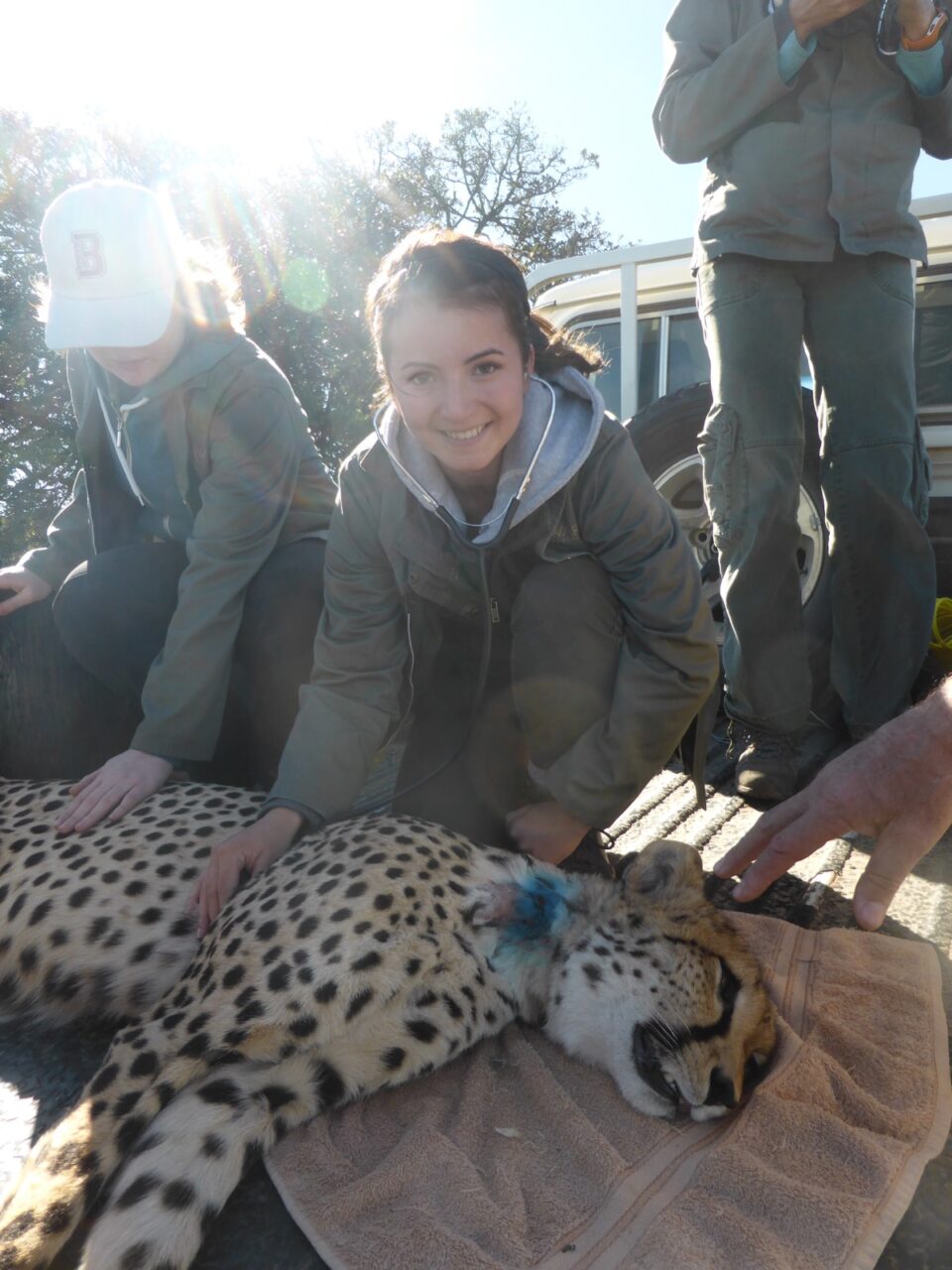
On another day we were tasked with moving some lions to a holding enclosure as they were being transferred to another reserve. After darting one of the lionesses, we had to jump off the jeep carry her onto the back of the pick-up truck and sit in the back with her while she was sedated for about a 15-20 minute drive where the holding enclosure was to make sure she was okay. It was pretty scary actually, your brain immediately jumps to the worst-case scenario where this lioness spontaneously wakes up and you have to evacuate off the side of a moving truck! Whenever there was an ear twitch we had to shout to Johan the vet, who was driving, and he would stop and come round and top up the sedation. You can see the slightly concerned look we all have!
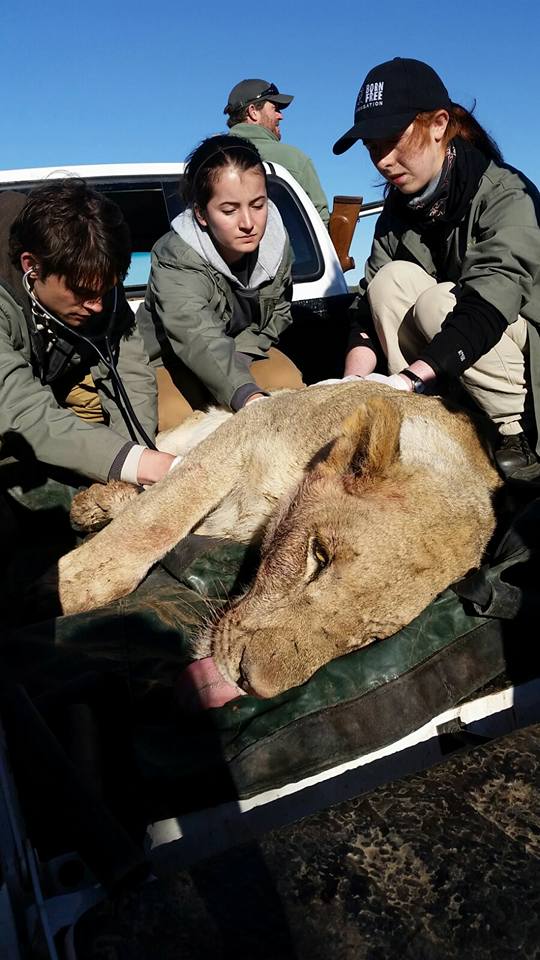
On one of the last days of the trip, we were dealing with an elephant who was in musth and causing problems on the reserve. He had been pulling up water pipes, breaking into compounds and acting very aggressively because of this period where they are sexually active and producing large amounts of testosterone. Musth is translated literally as ‘drunk’ from Urdu! Normally bull elephants at Shamwari in musth did not cause this much of a problem but in this case he was causing too much damage to be ignored. We darted him and a GnRH-antagonist was placed to reduce the production of testosterone and thereby reduce his dangerous behaviour. When elephants wake up after being sedated they have to rock from side to side to build up enough momentum to get back up again!
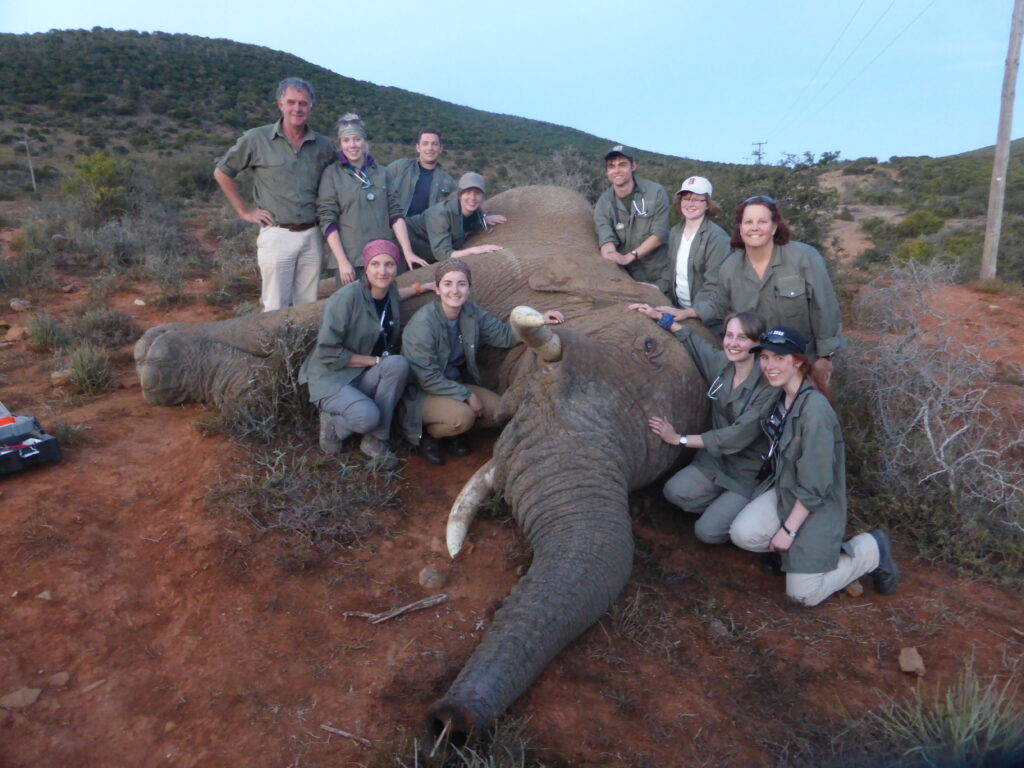
On both trips to Shamwari, we did a community day where we spent the day in the local village doing free vaccines and health checks for their pets. It was great getting to meet the local people and seeing the pets they brought in. It is the case, however, that because resources are limited there are a lot of unwanted animals due to lack of neutering. The first year I volunteered to do a PTS or ‘put to sleep’ (that would have been my first) on a dog that wasn’t wanted anymore. I couldn’t do it. I couldn’t settle it with myself that it was a perfectly healthy adult dog, I just found it too upsetting. The following year, I euthanised a litter of very young puppies that weren’t wanted. It was incredibly difficult and sad but I knew that if they weren’t wanted their life would be very hard and possibly unpleasant. Obviously, as a vet, you have to do euthanasia quite frequently and I felt it was important the second year to find a way to emotionally cope with it.
South Africa is a country that is very close to my heart and somewhere I absolutely love going to! I’ll definitely be making a trip back ASAP!
To see a video of my trips to SA click here!

























